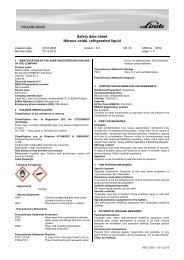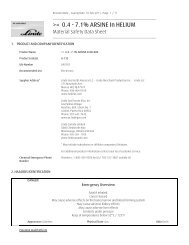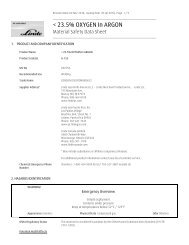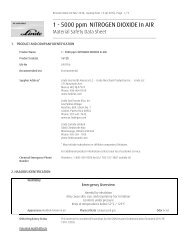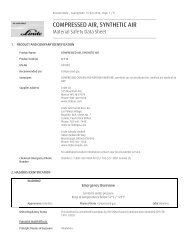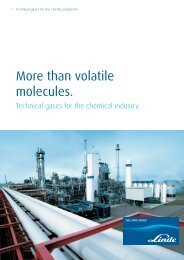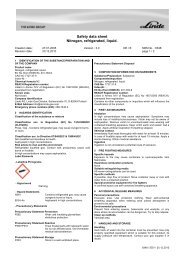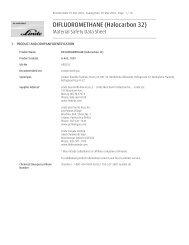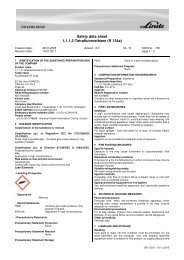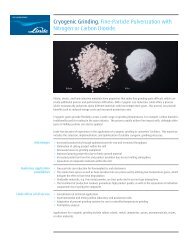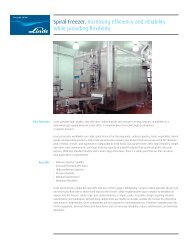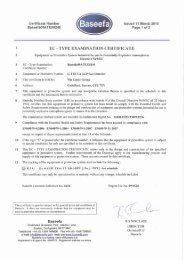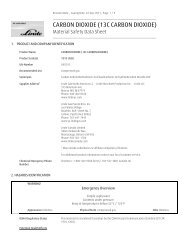SILANE - (MSDS) - Linde Gases
SILANE - (MSDS) - Linde Gases
SILANE - (MSDS) - Linde Gases
Create successful ePaper yourself
Turn your PDF publications into a flip-book with our unique Google optimized e-Paper software.
<strong>SILANE</strong>, Material Safety Data Sheet , Revision Date 02-Sep-2010, Page 3 / 9___________________________________________________________________Unsuitable Extinguishing MediaHazardous Combustion ProductsDo not use halogenated extinguishing agents or foam.Silicon dioxide.Explosion DataSensitivity to Mechanical ImpactSensitivity to Static DischargeSpecific Hazards Arising from theChemicalProtective Equipment andPrecautions for FirefightersNoneYesSilane is a pyrophoric gas that will generally spontaneously ignite upon contact with air. Forspontaneous ignition, however, certain silane concentrations, turbulence, and temperature of themixture must be satisfied. The greatest hazard of Silane is its unpredictable behavior when releasedinto the air. Continue to cool fire exposed cylinders until flames are extinguished. Cylinders mayrupture under extreme heat. Damaged cylinders should be handled only by specialists.If possible, stop the flow of gas. Do not extinguish the fire until supply is shut off as otherwise anexplosive-ignition may occur. If the fire is extinguished and the flow of gas continues, use increasedventilation to prevent build-up of explosive atmosphere. Ventilation fans must be explosion proof. Usenon-sparking tools to close container valves.Isolate spill or leak area for at least 100 meters (330 feet) in all directions. Vapors from liquefied gasare initially heavier than air and spread along ground. Vapors may accumulate in confined areas(basement, tanks, hopper/tank cars, etc.). Vapors may travel to source of ignition and flash back. Formassive fire, use unmanned hose holders or monitor nozzles; if this is impossible withdraw from areaand let fire burn.Use water spray to cool surrounding containers. Be cautious of a Boiling Liquid Evaporating VaporExplosion, BLEVE, if flame is impinging on surrounding containers.As in any fire, wear self-contained breathing apparatus pressure-demand, MSHA/NIOSH (approved orequivalent) and full protective gear.6. ACCIDENTAL RELEASE MEASURESPersonal PrecautionsEnvironmental PrecautionsMethods for ContainmentMethods for Cleaning UpELIMINATE all ignition sources (no smoking, flares, sparks or flames in immediate area). All equipmentused when handling the product must be grounded. Use personal protective equipment. Do not touchor walk through spilled material. Stop leak if you can do it without risk. Releases of Silane into air canproduce silicon dioxide.Prevent spreading of vapors through sewers, ventilation systems and confined areas.Stop the flow of gas or remove cylinder to outdoor location if this can be done without risk. If leak is incontainer or container valve, contact the appropriate emergency telephone number in Section 1 or callyour closest <strong>Linde</strong> location.Return cylinder to <strong>Linde</strong> or an authorized distributor.
<strong>SILANE</strong>, Material Safety Data Sheet , Revision Date 02-Sep-2010, Page 4 / 9___________________________________________________________________7. HANDLING AND STORAGEHandlingHandle in sealed, purged system. Ground and bond all lines and equipment associated with productsystem. All equipment should be non-sparking and explosion proof. Remove all sources of ignition.Use only in ventilated areas. "NO SMOKING" signs should be posted in storage and use areas.Pure silane is non-corrosive and may be handled in most common structural containers. Carbon steel,stainless steel, brass, Monel® & Hasteloy C are most commonly used materials. It also compatible withordinary glass, Pyrex®, and quartz. For gasket materials, Viton®, Nylon, Teflon®, and Kel-F® are allsatisfactory. Most all silane leaks will ignite in air producing silicon dioxide. Occasionally the silicondioxide will slow or stop the leak. Materials may accumulated behind outlet plug. Wear appropriateprotective equipmet and face outlet away when removing plug and connecting cylinder.Never attempt to lift a cylinder by its valve protection cap. Protect cylinders from physical damage; donot drag, roll, slide or drop. When moving cylinders, even for short distance, use a cart designed totransport cylinders. Use equipment rated for cylinder pressure. Use backflow preventive device inpiping.Use an adjustable strap wrench to remove over-tight or rusted caps. Never insert an object (e.g.wrench, screwdriver, pry bar,etc.) into valve cap openings. Doing so may damage valve, causing leakto occur. If user experiences any difficulty operating cylinder valve discontinue use and contactsupplier.Never put cylinders into trunks of cars or unventilated areas of passenger vehicles. Never attempt torefill a compressed gas cylinder without the owner's written consent. Never strike an arc on acompressed gas cylinder or make a cylinder a part of an electrical circuit.For additional recommendations, consult Compressed Gas Association's Pamphlet G-13.StorageOutside or detached storage is preferred. Protect from physical damage. Cylinders should be storedupright with valve protection cap in place and firmly secured to prevent falling. Store in cool, dry, wellventilatedarea of non-combustible construction away from heavily trafficked areas and emergencyexits. Keep at temperatures below 52°C / 125°F. Full and empty cylinders should be segregrated. Use a"first in-first out" inventory system to prevent full cylinders from being stored for excessive periods oftime. Always store and handle compressed gas cylinders in accordance with Compressed GasAssociation, pamphlet CGA-P1, Safe Handling of Compressed <strong>Gases</strong> in Containers.8. EXPOSURE CONTROLS / PERSONAL PROTECTIONExposure GuidelinesChemical Name ACGIH TLV OSHA PEL NIOSH IDLHSilaneTWA: 5 ppm(vacated) TWA: 5 ppmTWA: 5 ppm7803-62-5(vacated) TWA: 7 mg/m 3TWA: 7 mg/m 3NIOSH IDLH: Immediately Dangerous to Life or Health.Other Exposure GuidelinesEngineering MeasuresVentilationVacated limits revoked by the Court of Appeals decision in AFL-CIO v. OSHA, 965 F.2d 962 (11th Cir.,1992).Showers. Eyewash stations. Explosion proof ventilation systems. Exhaust gas should be vented to a gastreatment system. Monitor cylinders with hydride monitors to detect leaks and releases along withUV/IR monitors for flame detection.Use ventilation adequate to keep exposures below recommended exposure limits.Personal Protective EquipmentEye/Face ProtectionFor cylinder handling: safety glasses. For routine use (within 15 feet of Silane system): Safety glassesand face shield. For emergency operations: Fire helmet with faceshield, fire resistant hood.
<strong>SILANE</strong>, Material Safety Data Sheet , Revision Date 02-Sep-2010, Page 6 / 9___________________________________________________________________InhalationRepeated Dose ToxicityToxicological data for silane in the open literature is extremely limited. Four out of ten mice diedfollowing inhalation of 9600 ppm for 4 hours. The four hour LC50 value for the rat has been cited as4000 ppm and 9600 ppm. In the absence of subacute or chronic data for silane, the ACGIH TLV is basedon silicon tetrahydride being one-tenth as toxic as germanium tetrahydride. The margin of safetyassociated with this TLV has yet to be determined.No information available.Chronic ToxicityChronic ToxicityCarcinogenicityNone known.Contains no ingredient listed as a carcinogen.IrritationSensitizationReproductive ToxicityDevelopmental ToxicitySynergistic MaterialsTarget Organ EffectsMay cause irritation.No information available.No information available.No information available.None known.Central nervous system (CNS). Eyes. Respiratory system. Skin.12. ECOLOGICAL INFORMATIONEcotoxicityThe environmental impact of this product has not been fully investigated. Will not bioconcentrate.Ozone depletion potential; ODP; (R-11 = 1): Does not contain ozone depleting chemical (40 CFR Part 82).13. DISPOSAL CONSIDERATIONSWaste Disposal MethodsDo not attempt to dispose of residual waste or unused quantities. Return in the shipping containerPROPERLY LABELED WITH ANY VALVE OUTLET PLUGS OR CAPS SECURED AND VALVE PROTECTION CAP INPLACE to <strong>Linde</strong> for proper disposal.14. TRANSPORT INFORMATIONDOTProper Shipping NameSilaneHazard Class 2.1Subsidiary ClassNoneUN-NoUN2203DescriptionUN2203,Silane,2.1Emergency Response Guide Number 116
<strong>SILANE</strong>, Material Safety Data Sheet , Revision Date 02-Sep-2010, Page 7 / 9___________________________________________________________________TDGProper Shipping NameSilane, compressedHazard Class 2.1UN-NoUN2203DescriptionUN2203,<strong>SILANE</strong>, COMPRESSED,2.1MEXProper Shipping NameSilaneHazard Class 2.1UN-NoUN2203DescriptionUN2203 Silane,2.1IATAUN-NoUN2203Proper Shipping NameSilaneHazard Class 2.1ERG Code10LDescriptionUN2203,Silane,2.1Maximum Quantity for PassengerForbiddenMaximum Quantity for Cargo OnlyForbiddenLimited QuantityNo information available.IMDG/IMOProper Shipping NameSilaneHazard Class 2.1UN-NoUN2203EmS No.F-D, S-UDescriptionUN2203, Silane,2.1ADRProper Shipping NameSilaneHazard Class 2.1UN-NoUN2203Classification Code2FDescriptionUN2203 Silane,2.1,15. REGULATORY INFORMATIONInternational InventoriesTSCADSLEINECS/ELINCSCompliesCompliesCompliesLegendTSCA - United States Toxic Substances Control Act Section 8(b) InventoryDSL/NDSL - Canadian Domestic Substances List/Non-Domestic Substances ListEINECS/ELINCS - European Inventory of Existing Commercial Chemical Substances/EU List of Notified Chemical SubstancesU.S. Federal Regulations
<strong>SILANE</strong>, Material Safety Data Sheet , Revision Date 02-Sep-2010, Page 8 / 9___________________________________________________________________SARA 313Section 313 of Title III of the Superfund Amendments and Reauthorization Act of 1986 (SARA). This product does not contain any chemicalswhich are subject to the reporting requirements of the Act and Title 40 of the Code of Federal Regulations, Part 372.SARA 311/312 Hazard CategoriesAcute Health HazardChronic Health HazardFire HazardSudden Release of Pressure HazardReactive HazardYesNoYesYesYesClean Water ActThis product does not contain any substances regulated as pollutants pursuant to the Clean Water Act (40 CFR 122.21 and 40 CFR 122.42).Risk and Process Safety Management ProgramsThis material, as supplied, contains one or more regulated substances with specified thresholds under 40 CFR Part 68 or regulated as ahighly hazardous chemical pursuant to the 29 CFR Part 1910.110 with specified thresholds:Chemical Name U.S. - CAA (Clean Air Act) - U.S. - CAA (Clean Air Act) - U.S. - OSHA - Process SafetyAccidental Release Prevention - Accidental Release Prevention - Management - Highly HazardousToxic SubstancesFlammable SubstancesChemicalsSilane - 10000 lbs -Clean Air Act, Section 112 Hazardous Air Pollutants (HAPs) (see 40 CFR 61)This product does not contain any substances regulated as hazardous air pollutants (HAPS) under Section 112 of the Clean Air ActAmendments of 1990.CERCLA/SARAThis material, as supplied, does not contain any substances regulated as hazardous substances under the Comprehensive EnvironmentalResponse Compensation and Liability Act (CERCLA) (40 CFR 302) or the Superfund Amendments and Reauthorization Act (SARA) (40 CFR355). There may be specific reporting requirements at the local, regional, or state level pertaining to releases of this material.U.S. State RegulationsCalifornia Proposition 65This product does not contain any Proposition 65 chemicals.U.S. State Right-to-Know RegulationsChemical Name Massachusetts New Jersey Pennsylvania Illinois Rhode IslandSilane X X X - XInternational RegulationsChemical Name Carcinogen Status Exposure LimitsSilane - Mexico: TWA= 5 ppmMexico: TWA= 7 mg/m 3CanadaThis product has been classified in accordance with the hazard criteria of the Controlled Products Regulations (CPR) and the <strong>MSDS</strong>contains all the information required by the CPR.
<strong>SILANE</strong>, Material Safety Data Sheet , Revision Date 02-Sep-2010, Page 9 / 9___________________________________________________________________WHMIS Hazard ClassA Compressed gasesB1 Flammable gasD2B Toxic materials16. OTHER INFORMATIONPrepared ByIssuing DateRevision DateProduct Stewardship23 British American Blvd.Latham, NY 121101-800-572-650105-Mar-201002-Sep-2010Revision Number 1Revision Note (M)SDS sections updated. 1.NFPA Health Hazard 1 Flammability 4 Stability 1Physical and ChemicalHazards -HMIS Health Hazard 0 Flammability 4 Physical Hazard 3 Personal Protection -Note: Ratings were assigned in accordance with Compressed Gas Association (CGA) guidelines as published in CGA Pamphlet P-19-2009,CGA Recommended Hazard Ratings for Compressed <strong>Gases</strong>, 3rd Edition.General DisclaimerFor terms and conditions, including limitation of liability, please refer to the purchase agreement in effect between <strong>Linde</strong> LLC, <strong>Linde</strong> MerchantProduction, Inc. or <strong>Linde</strong> Gas North America LLC (or any of their affiliates and subsidiaries) and the purchaser.DISCLAIMER OF EXPRESSED AND IMPLIED WARRANTIESAlthough reasonable care has been taken in the preparation of this document, we extend no warranties and make no representations as to the accuracyor completeness of the information contained herein, and assume no responsibility regarding the suitability of this information for the user's intendedpurposes or for the consequences of its use. Each individual should make a determination as to the suitability of the information for their particularpurpose(s).End of Safety Data Sheet



